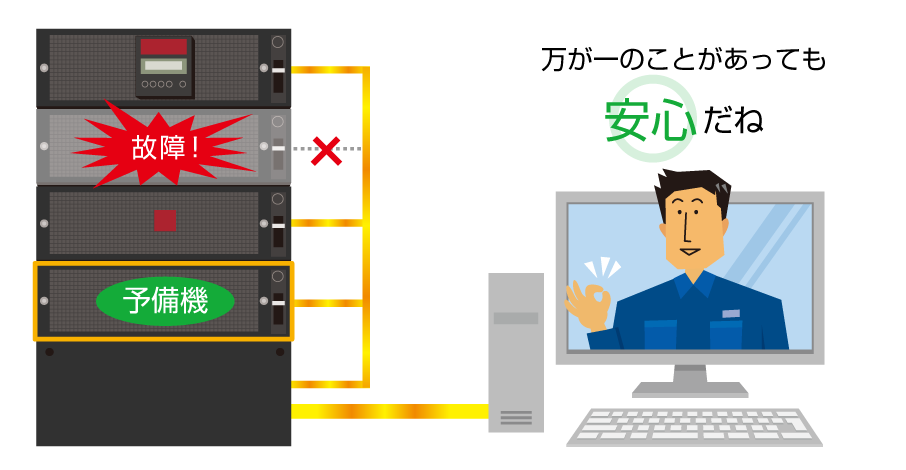



-
- Free Word Search




A stable power supply is extremely important in today's business environment. UPS (Uninterruptible Power Supplies) is particularly important in places where power supply interruptions have a significant impact, such as factories and data centers.
However, risk management measures in the unlikely event that a problem occurs with the UPS itself can be a blind spot.
This is where the "parallel redundant type UPS" has become popular. In this article, we will explain the basics of parallel redundant type UPS, its benefits, and our related series in detail.
A "parallel redundant system" is a system in which two or more UPS units with parallel operation capabilities are connected in parallel, instead of a normal UPS that operates independently. In the unlikely event that a problem occurs with one UPS, power can continue to be supplied from the other UPS units. This significantly improves the reliability of the power supply.
For example, by connecting three UPS units in parallel, even if one unit has a problem, the other two units can continue to supply power, improving the reliability of the entire system.

A parallel redundant type UPS not only provides reliability by protecting against the risk of a problem occurring with the UPS itself, but also offers a variety of other benefits.
By running two or more UPS Inverter units with parallel operation function in parallel, even if a problem occurs with one UPS, power can continue to be supplied from the other UPS Inverter units, significantly improving the reliability of the power supply.
Facilities where a power outage could cause severe damage, such as a factory's central monitoring system, instrumentation system, process computer, or server room, require a highly reliable UPS such as a parallel redundant type.
With a parallel redundant type UPS, you can increase the power supply capacity of the entire system by adding UPS units as needed. This allows you to flexibly respond to future increases in power usage. For example, even if your current power demand is 10kVA, if you need 20kVA in the future, you can respond by introducing an additional UPS unit.
Our units vary in capacity from 1kVA to 5kVA to 100kVA, so you can choose the optimum capacity for any situation.

If the UPS is in parallel redundant operation, you can replace a UPS unit without stopping the power output. If the UPS has a maintenance bypass circuit, you can replace the unit during bypass operation, so there is no need to stop the equipment.

SANYO DENKI offers a variety of parallel redundant type UPS to suit your needs.
It has a capacity of 5kVA to 20kVA, and up to four 5kVA units can be combined.
It is possible to operate in parallel with one unit as a spare unit.
It has a capacity of 5kVA to 20kVA, and up to four 5kVA units can be combined.
Because it is a lithium-ion battery UPS, it has the following features compared to the lead-acid battery-based SANUPS A11N.
●Long battery life (expected life 10 years *at 25℃)
●Wide temperature range (operating environment: 0~55℃)
●Space-saving and lightweight
Parallel redundant UPS systems are used in factories such as chemical plants, steel mills, semiconductor factories, pharmaceutical factories, and food factories, where power outages can lead to serious accidents. These systems can avoid the risk of UPS malfunctions, making them ideal for these factories. Lithium-ion battery parallel redundant UPS systems are also extremely useful for the following reasons:
●There are many UPS units in the factory, and the labor required for battery replacement needs to be reduced.
●The UPS can operate in a wide range of ambient temperatures.
● Space is limited

It has a capacity of 1kVA to 8kVA, and up to eight 1kVA units can be combined.
This is a rare type of UPS in the industry, in that it allows you to create a parallel redundant system even with a small capacity by combining 1kVA units.
In addition, the UPS has the following features that make it suitable for use overseas:
●Complies with UL/CE/UKCA standards
●In addition to 100V models, 200V models are also available
●Wide range of input power
(100V type is 55 to 150V, 200V type is 110 to 300V, input frequency range is 40 to 120Hz *When the load factor is less than 40%)
●No need to worry about differences in outlet shapes due to the terminal block specifications
For this reason, the SANUPS A11M is highly valued for being incorporated into equipment used overseas and for providing power to production facilities overseas.
●I want to prevent battery deterioration even when I'm abroad and the power situation is unstable.
●Since the capacity is small, it is desirable to incorporate it into equipment
●I want to avoid the risk of UPS problems at production facilities, etc.
We also recommend this article: Explaining precautions and safety standards when using UPS overseas!

With capacities ranging from 6.25kVA to 25kVA, by combining 6.25kVA units, a wide range of power capacities can be supported up to a maximum of 25 kVA, or up to 18.75 kVA with parallel redundancy.
It is three-phase and has a choice of capacities starting from 6.25kVA, and has the following features:
The industry's smallest installation area per output capacity. (As of August 31, 2023. Based on our research, assuming the same power supply method, voltage, capacity, and backup time as a UPS.)
● Expected product life: 15 years (average ambient temperature 30℃, when necessary inspections and part replacements are carried out)
●Each module (display, UPS module, bypass) is plugged in, and the battery tray is connected by a connector.
Even in situations where it is undesirable to stop the supply of power to factory equipment or production facilities, for the following reasons:
They are useful
for backing up central monitoring systems, semiconductor manufacturing equipment, PLCs, medical analysis equipment, and testing equipment.
●While three-phase UPS were only available with large capacities, you can now choose from 6.25kVA.
●Can be installed in a limited space.
●Each module can be removed from the front of the device, making maintenance easy.
It has a capacity of 100kVA to 600kVA, and by combining 100kVA units, it can accommodate a wide range of power capacities.
This is a high-capacity, energy-efficient UPS that is suitable for situations with high power demands, such as large-scale factory equipment and production facilities.
With capacities ranging from 5kVA to 105kVA, a wide range of power capacities can be accommodated by combining 5kVA units.
It also complies with CE/UKCA standards, making it suitable for use in a wide range of situations, including overseas.
We also recommend this article: Explaining precautions and safety standards when using UPS overseas!
If you have any requests such as "I want to prepare for the risk of a parallel redundant UPS in case the UPS itself experiences a problem," or "I want to choose a UPS that suits my company's environment," please feel free to contact us at any time. We look forward to hearing from you.
Release date: